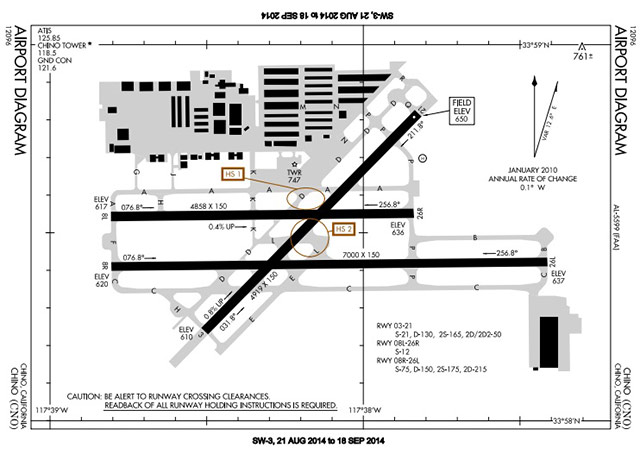As your destination airports grow in size and complexity, the ground phase of your arrival will benefit from careful advance research tapping a variety of information sources. Unlike arrivals at smaller airports where it is a simple matter to exit the lone runway at a single taxiway located at mid-field and taxi to the ramp, getting to where you want to go now becomes a matter of careful ground-route navigation before you finally shut down in front of the FBO.
Checking your destination’s listing in AOPA Airports, you will find specialized information to help you deal with larger airports’ operations. An important reference tool is the airport diagram, such as this one for California’s Chino Airport, where AOPA’s next regional fly-in of 2014 will be held on Sept. 20. Linked from the airport listing’s instrument procedures section, the airport diagram gives you an up-close look at the airport’s physical layout, and shows infrastructure such as taxiways, control tower, and other structures. Perhaps most important is that the airport diagram points out the location of any “hot spots” on the surface. (The FAA identifies a hot spot as “a runway safety related problem area on an airport that presents increased risk during surface operations.”)
How do you learn the specific nature of a hot spot?
Clicking the directory listing’s hot spot link will take you to the airport/facility directory hot spot list, where the proximity of two of Chino’s taxiways to adjacent runways was noted as two hot spots, as shown in the A/FD edition valid through Sept.18. (Be sure to use the current edition of the A/FD and other flight-information publications when looking up airport and procedural information.)
Researching details of a hot spot is a good example of how a pilot may have to use multiple sources to acquire all available information about a destination airport.
Airport diagrams’ depictions of complex networks of runways and taxiways help you visualize, before flying, how to get where you are going on the airport from any runway you land on. So study the appropriate airport diagram carefully during your flight planning, even if you plan to request progressive taxi instructions after you have landed.




